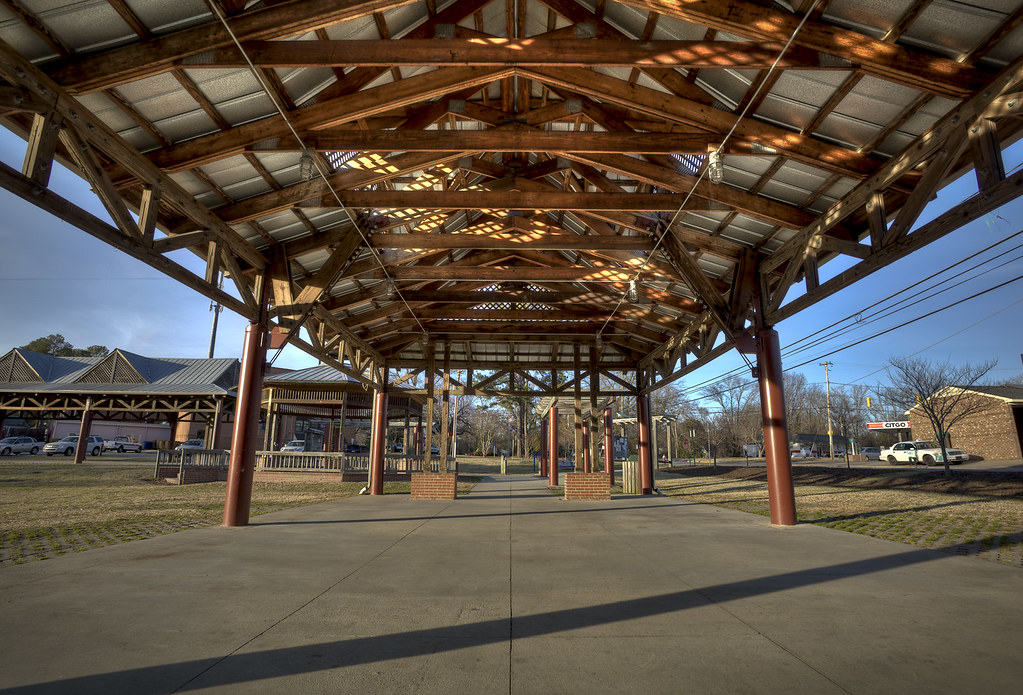 42/365: Empty Market, Carrboro, NC
42/365: Empty Market, Carrboro, NC
For better or for worse, I'm done with my mandatory 'Strobist' theme here on the blog, and I'm starting my next theme, which will be High Dynamic Range Images, aka HDR...
Some of you may know what HDR is, and may even have an opinion on it. I'd venture that every photographer that's reading this has an opinion on HDR, perhaps a strong one. For the uninitiated, here's a quick breakdown:

When you create an HDR image, you take multiple exposures of the scene and try to capture the entire range of light, from the darkest areas to the brightest. It's best to have the camera on a tripod so each exposure lines up with the next, and it gets complicated when objects move between shots, so the technique is only applicable to certain subjects (these rules aren't fixed, and we'll get to that eventually). You start at the darkest exposure that can just capture the brightest areas in your shot, then increase your exposure in increments until you take the brightest exposure that can capture the darkest areas. Like this:
It gets even dorkier after that. This is a software-intensive technique: it requires special programs that can take all the shots and merge them based on complicated algorithms and wizardry of the highest sort. And not just Photoshop, Max, in fact, PS does a shitty job for the most part with this stage in the process. The most common program, and the one I use, is Photomatix, but it's not the only one, and it may not be the best in all situations. The program does its math and what-not, and you get a true High Dynamic Range image. It captures the range that your eye can see and maybe more. In fact, it captures more than your monitor can display: that's right, our screens, and even photo paper, can't actually display the full range of light that our eyes can see, and the HDR image contains. So then, you have to use the programs to 'tonemap' the image, which basically takes all that information and compresses the tones into a lower dynamic range that you can see on a screen, or print on paper...this may sound like we're going backwards, but not really. The new image now has visible information in all the areas that it previously couldn't get in the same exposure. The shadows are still shadows, but they are brighter than black and have detail. The highlights are still highlights, but they are just short of detailess white. Now the image can go over to Photoshop for more editing, if needed.
The tonemapping process is what gives HDRs a certain look, and can result in images that look very strange in some cases. Notice I didn't say good or bad. In the process, you can go from anywhere between heavy-handed, which results in hyper-colorful/contrasty/textury images, to subtle, which may not even look much different that a standard photograph. Here's the thing about HDR, for those of you who don't know: it's a hot button issue with some dorks photographers. They love it or hate it. Or, they love one approach, the subtle one, and hate the extreme treatment. The common argument goes like this: HDR, when done in a subtle fashion, captures a scene more like how our eye sees the scene (in the way I mentioned earlier), but when tonemapped in a less subtle way, becomes ugly, unreal, garish, and 'Harry Potter-like' to quote one proponent of this argument.
I have a problem with this take. It's the part about how our eyes see the scene. Anytime I watch someone doing a tutorial on HDR and they say, "This is more like how my eye saw the scene," I think, 'No, it's not.' It just makes it more like a traditional photograph. I'm sorry, but increasing the available detail and dynamic range of a photo may make it closer to how the human eye works in theory, but there's so many other things that make our vision one thing and a photograph something else entirely. Our vision is stereoscopic, rife with blind spots that our brain fills in, blurry except for one tiny point, tunneled, peripheral. In short, subjective. A photo is a record and representation of light, and if I may skip over all the journeys between that definition and this one, it's a piece of art. And so in my opinion, the artist is free to do whatever they care to do with the image, subtle or not. The problem may be that there are lots of people making bad imagery with HDR, but the same can be said of photography in general. And of course, 'bad' is subjective. I think one point that has been made here on the blog by my friend James Ball is valid: a lot of HDR imagery can be lacking in contrast, since all the tones have been compressed so much closer together, and so the eye can't find a point to really be attracted to. But that's a hallmark of many a bad image, and HDR is only a factor in the final flatness with which the image falls.
I'm rambling on, but I'll continue this debate as I work thru this theme. I'm not going to pass judgement on HDR in general yet, but I'd like to spend a significant time with the technique and try the extremes in order to see what's possible, to get better at it, and to see what your reaction to the images is. After all, it could just be garbage in the end...
-llg


